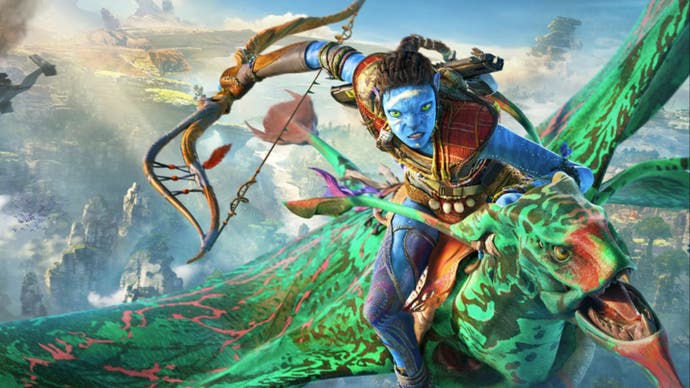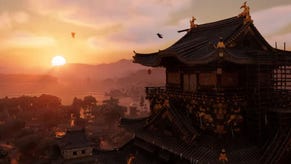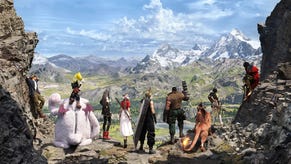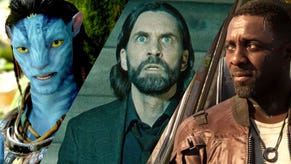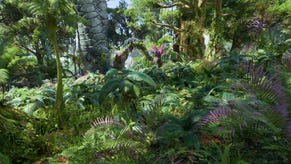Avatar: Frontiers of Pandora review - a surprisingly harmonious tribute to James Cameron's cinematic universe
RDA gaga.
Avatar: Frontiers of Pandora first clicked for me when things got grim. Away from the cascading ferns and artfully twisted tree trunks, far from fronds and petals and whole plants that briskly pulled themselves underground as I approached, I found an RDA camp that seemed to be mining something from the earth. The RDA are the villains in this world, and they're us: they're the humans. Here, they had sunk a bunch of tall metal towers into the ground and turned the surrounding area to sludge. The grass was gone. The rocks were black with oil and smoke. Steam belched unpleasantly from many boxy, ugly pieces of technology that all seemed to come with grates and vents and nasty little legs to keep them from toppling on the seismic terrain. It was grim and abhorrent and I loved it.
These RDA camps crop up quite a lot throughout the course of the game, growing massively in complexity and challenge, sprouting indoor sections, underground sections, aerial sections, moving from minor set-piece to major dungeon. But they're all variations on a theme, the theme being the trashing of paradise. You're meant to feel angry, I think: how could you take the blue sky and green forests, the bounding creatures and the bioluminescent fungi and do this with it? Space nature's laid on a disco for you here, and you want to just churn it all up, drill into it, crack it open? In truth, though, these camps always made me delighted. They meant that I was in for a bit of stealthing and a bit of sabotage and a bit of panic, working my way around huge mechs, picking off lone sentries, pulling this leaver, winding that wheel, shooting these glowing weak spots when they appeared to gout smoke into the air. And then...?
In Frontiers of Pandora, you play one of the Na'vi, the tall blue indigenous population of Pandora who are trying to push back against a human invasion. This means quests and rushing across an open world and leveling up and skill trees and loot that boosts your stats, all of that classic Ubisoft stuff. But in these RDA territory sequences, I truly felt the fiction of it all. Inside the RDA's installations there would be heavily armed soldiers and patrol routes and big stompy mechs. All that and a handful of targets I needed to reach to deactivate machines or blow them up, or download something, or free something. You get the gist.
I've heard a few people complain about the cut-and-paste elements in some of these sequences - the bases grow massively outwards, but the same variables crop up now and then. You often turn the same wheels and pull the same switches as you navigate the same mechs. But firstly: that's the RDA isn't it? How fit for the repetitive nature of open-world game design are these guys? The whole point of them is that they're imposing homogeneous grey cruelty on a world of variation and colour. Secondly: I never tired of this because the fiction really came alive in these moments. No matter how much I had levelled up, how many weapons I had unlocked and how good my clothes were, I was out-gunned here, so I had to approach things carefully, picking stragglers off with a bow - and being rewarded with a little toot from a pan-pipe to tell me I had done it without being spotted - and then sneaking through the facility, monitoring my objectives using Na'vi vision, marking enemies I could not really afford to take on and ensuring that I had an exit route if things went wrong.
And things always went wrong. That's another part of the glory of these sequences. If you've played a Far Cry game, which is easily Frontiers of Pandora's closest touch-stone, you'll know that moment where stealth falls apart and you really just have to run and gun and hope. I ended up seeing the early RDA camps in particular as a variation on a kind of birthday cake sat on a platter. I would rush in, take a bite, get spotted, and then rush back out again, turning and circling before risking another incursion, another bite. Later, they become more overwhelming: things you are lodged deep inside, working your way through. But still, that asymmetry. You may steal a rocket launcher for a few seconds, but a lot of the time you're using a bow and your enemies are scrambling at you from every direction.
Are these the best parts of the game? They're certainly my favourite. But they're not alone by any means. I'm not a massive fan of Avatar as a film series and I think I probably have a lot of the same problems with Ubisoft open-worlders as most people. Furthermore, I'm on this review here because our original writer hit a game-breaking bug many hours in, and Ubisoft's suggested workarounds didn't come in time. Hardly the most auspicious of introductions. But Frontiers of Pandora won me over. It starts strongly, in an escape-the-RDA sequence which brilliantly highlights the fact that as a Na'vi you're massively taller and more athletic than the people coming to trash your planet. Then it really aces the moment you emerge from the steel and rebar world of your oppressors into the bright, living forest that the rest of the game explores. And then, throughout all the regular Ubi stuff, you get these memorable moments scattered around.

Yes, up-front: a lot of Ubi stuff. The map is a lot more restrained with its objectives, and if you want you can ignore some of the intricacies of loot, but by and large this is a game about exploration, hunting, crafting ammo and food for health, and working through story missions and side quests. It has its own quirks: your best weapon is a bow, and I love it, although you can also lob bombs and place mines and chuck javelins from a sort of mounted cannon and even use a range of RDA weapons scaling up towards really explosive stuff. It also places an emphasis on traversal as a dialogue between you and the world, as you rush and slide, but also use natural bounce-pads made of leaves, and ride vines to receive sudden bursts of air. Even indoors, in RDA's land of ductwork and piping, there's still a bit of Tony Hawk as you glide and jump and gain height.
And speaking of height, although I gather the game takes place in a part of Pandora the films have yet to reach, you can still enjoy those floating islands once you've unlocked your own Ikran, a sort of psychedelic pterodactyl who you're encouraged to see as an extension of yourself as much as a handy means of getting from A to B. (Those floating islands can't help but bring back memories of Grow Home, incidentally. I spent a long time swooping between them and landing even when I wasn't on missions.)
But these moments of singular pleasure! Take the Ikran. The game holds it back for a few hours, and then you're sent out to find one and bond with it. You're told Ikran can be flighty, so I was a bit nervous. This was also, I was aware, where our first reviewer and other people had encountered that bug that stopped them from proceeding, so that didn't help with the anxiety. Yet as I climbed the mountain to find my Ikran I realised I wasn't just anxious - I was excited.
And the game had made me excited through pacing and stagecraft, as I worked through this riddle of pathways and platforming challenges and gentle puzzles involving leaves that act like locked doors. I was headed somewhere exciting, and the music swooped in to push me along and the level design gave me these moments where I could coast a bit before being challenged. It was just a really well-made thing I was exploring, not a billion miles away from the craft I had encountered last year in Tears of the Kingdom when Link is working through a storm to approach the game's first dungeon. It's level design, but it's also this glorious bit of amping up.
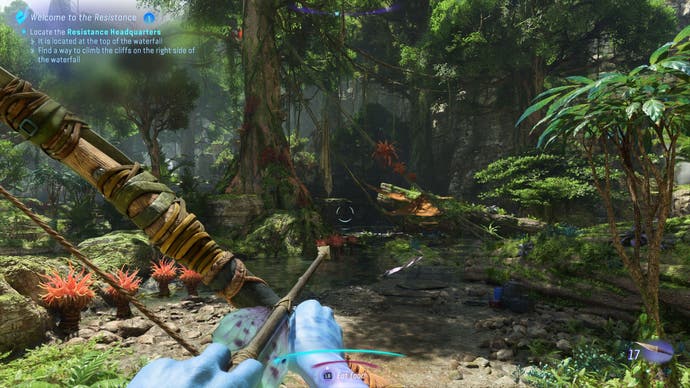

And yes, Ikrans are fun, it turns out. My game did not bug and pretty soon it was Far Cry territory, with more and more of a focus on action and gunfights, but I could fly through the air, swooping up high on the back of this beast, and even standing to fire off arrows and take out nasty RDA helicopters when the moment called for it. There are instances where I needed the Ikran to take me between RDA control platforms that needed to be hacked and destroyed - hacking mini-games, this really is a Ubisoft joint - but I could also use the Ikran in standard encounters, where there was a base that needed cleaning out, or one of those camps that needed smashing to pieces. I could hop on, fly away from danger, dally a while with an enemy chopper and then return refreshed, as they say in the adverts. Yes, you could argue that Ikrans don't handle particularly smoothly - on the wing they do feel more like gadgets than actual beasts - but they make the game more flexible, one dodge-roll and air-tunnel traversal at a time. And rather than the skill trees and the slow trickle of new weapons and clothes, it's these sorts of things that make the game feel nimble and exciting.
Because Pandora in the films is such a big draw - it's the thing everyone's fighting for, and it's also this endless wall-to-wall special effect inspired not just by Earth's own rainforests and jungles but by the deep ocean worlds that James Cameron likes to explore - combat and traversal, that sense of being deep in the world, share the main brunt of the game here.
Yes I love the RDA camps, particularly some of the ones further in which are drilling platforms on a giant scale but also, somehow, medieval castles at heart, filled with flames and poison and all kinds of danger. But I also love sequences like an earlyish kite-raising moment, the last part of the game I'll spoil, where I headed out into new territory on the back of a Direhorse - which, for any Word users here, is basically a shift-F7 normal horse but with scales - and for what felt like an age I simply moved through the world, directed not by the map or by glowing waypoints (although I could consult the former and summon the latter if I wished) but by tethered kites stuck in the actual world around me.
I raced under arches that may have been trees or may have been the ancient ribcage of something massive. I crested hills and saw a new landscape below me (these overlook moments, often combined with a bit of encounter planning, are a reminder of how much modern open-world games still owe to the hunter-based rhythms of Crysis), and sure, sometimes I raced across swaying grass and the lighting glitched, creating buggy flashes of light that made the foliage around me look fake, but I could look past that for the freedom of being alone in such a vast space and being left to find my own path.
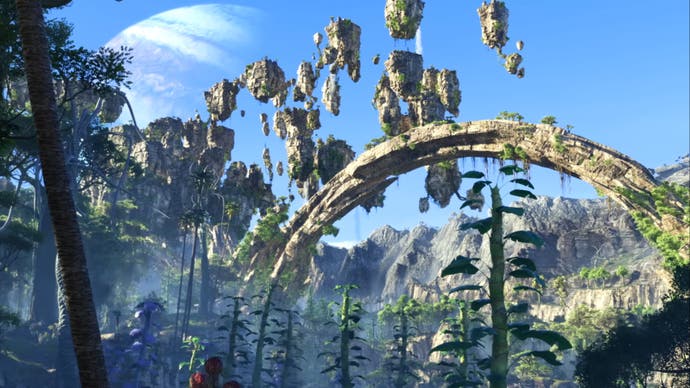
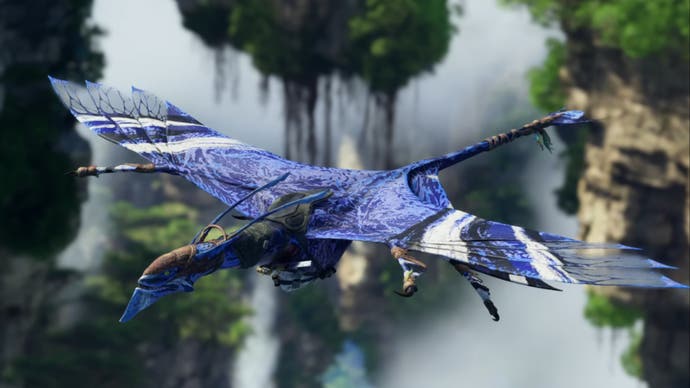
So yes, it's a massive game, and slightly exhaustingly so in places. Pandora brings lushness but also the kind of visibility problems you'd expect in some battles (that Na'vi vision that picks out enemies is not just there to sell the fiction). There's a lot of formula and a fair amount of repetition. The further you go, the more the game grows perhaps too hectic for its own good. But there are moments that feel special, too, and moments I'll remember.
And that's the thing I've been pondering over the last few days. Two things, actually. Firstly, why does this fiction that I'm not particularly bothered about work so well here? And why does Cameron's vision make so much sense nestled inside Ubisoft's standard way of doing things?
I think the answer to both questions is that there is a surprising harmony at work. The more I've been thinking about this, the more I've realised that the thing that possibly marks out Cameron's movies is a unique combination of elements. He makes films that are heartfelt but also deeply calculated. Maybe I have that back-to-front: James Cameron, blockbuster tyrant and regular Titanic visitor, makes films that are calculated but also disarmingly, gushingly heartfelt. Doesn't that sound like a lot of Ubisoft's stuff?
Honestly. Watch Cameron on a National Geographic documentary talking about how he made sure his personal submersible design could carry him to the depths of the ocean safely, and you get the director who demands that nothing happens on set that he does not foresee. But watch - and I cannot believe I'm typing this - writer, spiritual leader, failed presidential candidate, and serious Avatar Stan Marianne Williamson talking to him on a podcast about the ways that Avatar's milieu has informed her approach to actual global politics, and you see a completely different side of him. Tentative, glossy-eyed, a total believer. James Cameron is a glimpse of what you might get if Napoleon had marshalled his armies and influence in order to turn out chocolates with the very softest of centres.
Maybe that's even seen in the two worlds of Frontiers of Pandora. Indoors where the RDA have covered everything in metal plating and ductwork, where everything is a drill or a gun platform. Outdoors, where the Na'vi are at home and you have those jungles and vines, but also bright Fraggle Rock caves, savannahs, weeping gorges, ancient forests. Two worlds come together, at least two worlds. And, despite the fiction, they connect pretty neatly.
